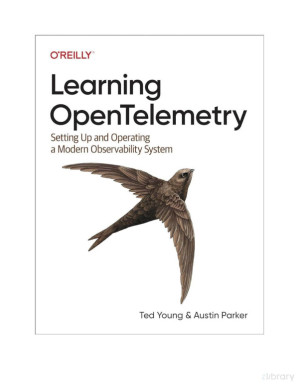Insights from Learning Open Telemetry: Setting Up and Operating a Modern Observability System
As someone who has spent countless hours troubleshooting distributed systems, I understand the struggle of trying to untangle metrics, logs, and traces spread across multiple tools. That’s why Learning OpenTelemetry by Austin Parker and Ted Young resonated with me. This book introduces OpenTelemetry, a game-changing framework for observability that unifies these disparate signals into a cohesive system. Whether you're new to observability or a seasoned developer looking to adopt modern practices, this book provides the tools and insights to make your systems more transparent and easier to debug.
I chose this book because observability is critical in today’s cloud-native and distributed architectures. Learning OpenTelemetry not only explains the technical components of OpenTelemetry but also its significance as a paradigm shift in monitoring and debugging modern systems. This book offers practical guidance and a vision for the future of observability.

Summary
Part 1: Foundations of Observability
Chapter 1: The State of Modern Observability
This chapter sets the stage by discussing the challenges of monitoring distributed systems. Traditional monitoring tools fail to provide the correlation needed to understand complex interactions in modern architectures. OpenTelemetry addresses this gap by unifying signals like logs, metrics, and traces into a “single braid of data.” A standout moment for me was the analogy of "three pillars" of observability being akin to "three separate browser tabs," emphasising the inefficiency of siloed systems.
Chapter 2: Why Use OpenTelemetry?
The authors delve into the "why" of OpenTelemetry. By standardising telemetry data and providing both "hard" and "soft" context, OpenTelemetry enables developers to correlate signals across systems efficiently. The discussion of limitations in traditional telemetry and OpenTelemetry’s advantages especially for dynamic environments like Kubernetes stood out.
Part 2: Components and Implementation
Chapter 3: OpenTelemetry Overview
This chapter introduces OpenTelemetry’s core components, including its ability to emit traces, metrics, and logs, and the protocols for collecting and transmitting telemetry data. The authors emphasize how OpenTelemetry integrates seamlessly with cloud-native ecosystems. I found the explanation of "semantic telemetry" particularly insightful it’s a game-changer for unifying data analysis across systems.
Chapter 4: Hands-On with the OpenTelemetry Demo
This chapter provides a hands-on introduction to the OpenTelemetry demo, showcasing its components in action. The step-by-step instructions for setting up and visualizing telemetry data helped solidify my understanding of how OpenTelemetry operates within an observability stack.
Chapter 5: Application Instrumentation
Instrumentation is at the heart of OpenTelemetry, and this chapter explores best practices for adding telemetry to applications. The authors provide a checklist to ensure high-quality telemetry data. I appreciated the focus on making instrumentation seamless and non-intrusive for developers.
Chapter 6: Instrumenting Open Source Libraries
Here, the book shifts to open-source libraries, explaining why maintainers should care about observability. The discussion of instrumentation strategies for libraries and shared services offered a new perspective on how to contribute to the broader OpenTelemetry ecosystem.
Chapter 7: Observing Infrastructure
This chapter reviews approaches for observing infrastructure like cloud platforms, data services, and Kubernetes. The emphasis on leveraging OpenTelemetry to unify observability across diverse components stood out as a practical guide for systems engineers.
Chapter 8: Building Scalable Observability Pipelines
OpenTelemetry’s Collector is at the center of this chapter, which explores building observability pipelines to process and export telemetry data. The authors highlight deployment patterns and strategies for scaling telemetry collection in production systems.
Chapter 9: Deploying OpenTelemetry Across an Organization
Rolling out OpenTelemetry isn’t just a technical challenge it’s also an organizational one. This chapter provides strategies for successful adoption, including ways to align cross-team efforts and avoid common pitfalls during implementation.
Key Takeaways
Key Takeaway 1: Observability Requires Unified Telemetry
- OpenTelemetry unifies logs, metrics, and traces into a single framework, providing a vendor-neutral, standardised approach to observability.
- Quote: “Instead of three separate pillars, think of telemetry as a single braid of data.” – (Chapter 1)
Key Takeaway 2: The Importance of Context
- OpenTelemetry introduces "hard" (unique identifiers) and "soft" (metadata) contexts to correlate signals across systems effectively.
- Context simplifies debugging by making it easier to link events and identify the root cause of issues.
- Quote: “Hard context defines relationships; soft context provides unique dimensions to explain signals.” – (Chapter 2)
Key Takeaway 3: Open Standards Future-Proof Observability
- OpenTelemetry's use of open standards ensures compatibility across platforms and eliminates vendor lock-in.
- Adopting open standards is crucial for organisations aiming to reduce costs and improve maintainability.
- Quote: “OpenTelemetry isn’t just an emerging standard; it’s inevitable.” – (Chapter 2)
Key Takeaway 4: Scalability Is Essential
- OpenTelemetry’s Collector enables scalable telemetry pipelines, critical for handling the data demands of modern distributed systems.
- This reinforced the need for robust, scalable infrastructure in any observability strategy.
- Quote: “OpenTelemetry makes scalable observability pipelines achievable for any organisation.” – (Chapter 8)
Personal Reflections
Reading Learning OpenTelemetry deepened my understanding of observability as both a technical and organisational practice. The book’s emphasis on standardising telemetry and integrating it seamlessly into systems was particularly impactful. I found the practical examples and actionable advice helpful for envisioning how OpenTelemetry could transform my approach to debugging and monitoring distributed systems. It also sparked ideas for enhancing collaboration between development and operations teams.
Conclusion
Learning OpenTelemetry is a must-read for anyone involved in managing modern systems. It demystifies observability and positions OpenTelemetry as a cornerstone of effective debugging and monitoring practices. Whether you're a developer, operator, or manager, this book equips you with the knowledge to navigate and thrive in the cloud-native era. I highly recommend it for its actionable insights and vision for the future of observability.